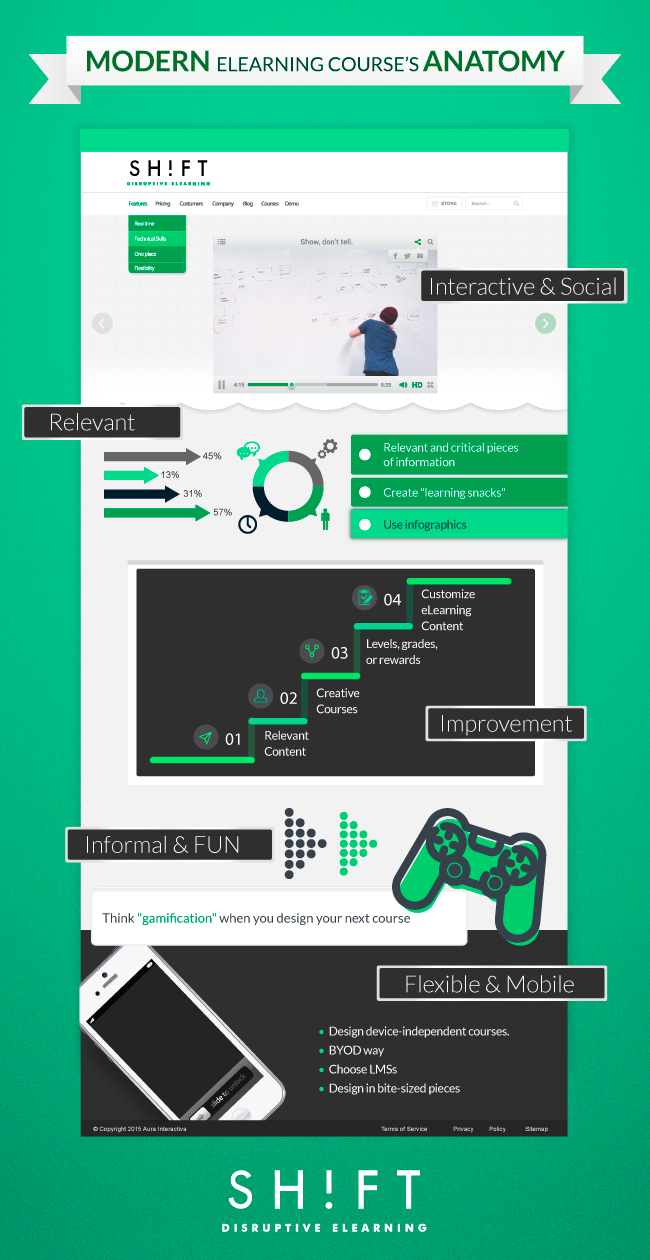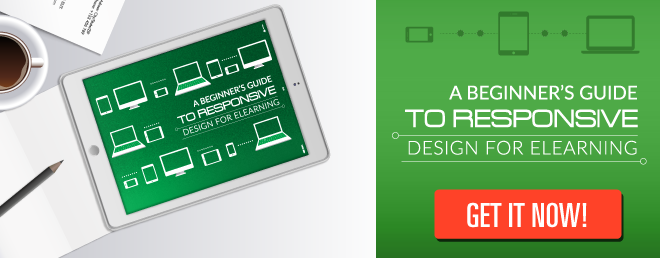Workplace learning used to be different.
In the last decades, learning was considered just an event. People studied four-year careers only, pursued a job for life, and then retired.
But times have changed—and today’s employees no longer see learning as a one-stop shop for a job.
Lifelong Learning is now more important than ever. And that’s more true for Millennials and Gen Z workers than just about any other group.
These are the modern learners who are vastly different temperamentally, attitudinally, and psychologically than their predecessors, the Baby Boomers.
As someone who has to cater to the needs of these new generations in the workplace, you have to create eLearning courses that appeal to their unique behaviors and learning preferences. You have to adapt your strategy and start designing learning experiences that will hook and keep them glued to the screen and make them wonder what more you have in store for them.
Become familiar with the anatomy of a modern eLearning course:

1) It Is Interactive and Has Social elements
Modern learners are tech-savvy. They have grown up handling technology. One-way and passive courses are not for them!
Forget PowerPoint slides! Say bye-bye to boring PDF training manuals. Instead, design eLearning courses that let the learners interact with the content. Today’s learners are very self-directed and comfortable with an active approach to getting content, so pepper your eLearning courses with interactive activities that make them think, let them act, and steer the course of the learning themselves.
Scenarios with relatable and believable mentors and settings, quizzes, games, and social environments that facilitate (friendly or feisty) exchanges with peers and competitors are some oft-used interactive tools you can use to make your courses engaging.
So here's your golden rule: Show, don't tell.
2) It Has "Relevance" Written All Over It
Modern workers are not only short of time but also get easily distracted. Social media, smartphones, emails, reading blogs, whatever is beaming on the television—there is no dearth of "attractions" vying for his attention.
So you have to make your point right away; beat around the bush and your learner will exit from the course. Present only meaningful content; they have no time for fluff. They want to be sure they will be immediately applying what they are learning to real-life situations in the workplace.
Here's what to keep in mind when you create content for the modern learner:
- Focus on offering useful tools, performance support, and actionable resources. that include only the most relevant and critical pieces of information.
- Think in bite-sized chunks of content that the learner can go over in two, five, or at the most 10 minutes. Forget the hour-long lectures that worked well with the Baby Boomers. Use a microlearning strategy and here's why.
- Give on one task at a time. Do not crowd the screen with multiple ideas.
- Go visual to make your content easy to grasp. Consider using infographics; these are all over the Internet, and the modern learner likes this format.
Read: Stop Blah, Blah eLearning! 5 Rules for Creating Relevant and Fluff-free Courses
3) It Promotes Career Development
As the saying goes, if you don’t know where you’re going, how will you know how to get there? This applies to your eLearning courses too.
Modern learners want to feel like they’re “leveling up” and not just remaining stuck in their careers, doing random courses that are not adding up to a bigger plan. If they feel the learning opportunities are few and far between in their current organization, they will move on to a new job in another company. As a training manager, you know the cost of replacing an employee.
Here's how you should create courses that will give employees an increased sense of purpose in their present jobs:
- Ensure that your eLearning courses pack in enough relevant content that will let employees build their marketable skills.
- Build courses that make learners exercise their creative thinking and analytical skills. Help your employees grow, so they know their organization has their best interests in mind.
- Build more levels, grades, or other types of rewards and recognitions in your course to give the modern learner the gratification of knowing that he is making progress at the workplace.
- Make sure you communicate early on how your eLearning course is part of their career path.
4) It Is Informal and Fun...There is Play In It!
Modern learners have read more blogs than humongous classics. They express their thoughts in one-liner status updates and tweets in the language of their heart. So no matter what the topic is, you should make learning experiences fun by adding continuous informal learning activities (video, mobile, micro, and social learning, coaching, etc).
Also, lighten up the serious tone! Make learners comfortable with writing in a language that is informal and conversational. Ditch the formality by talking to them and NOT talking down.
Games specifically are excellent tools to bring a breath of fresh air into a complex or staid subject matter. Regardless of your audience or subject matter, gamifying content can help you boost excitement among your learners.
Millennials and Gen Z workers were born into video games. They not only like to play games but also thrive in a competitive environment where their efforts are rewarded—access to higher levels, weapons unlocked, "lives" increased, and gold coins added to the kitty. You speak to them when you incorporate games into your courses.
Here are some ideas:
- Transform modules into challenges: Instead of plain content modules, offer a series of small, achievable challenges throughout the course and increase their difficulty level as the student progresses.
- Levels are another sign of employee progress: You can organize your course in levels and present new content and new challenges to keep learners motivated.
- Storytelling: Create a story-themed course that embeds your workers in the plot as they tackle each section of the content.
- Digital badges: Badges are tangible and visible forms of an achievement. Using them in your eLearning courses as a reward can make it more desirable for a worker to complete the course.
5) It is Flexible, Convenient, and Mobile
Modern learners love to have things go their way. They want to be able to control the pace of their learning and decide when and where they learn. So don't create courses that tether them to the desk or make them reschedule their already-overflowing calendar. Create courses that they can take on the go and that smoothly integrate into existing employee workflows and technology ecosystems.
Make the most of available technology to reach out to your learners in the way they prefer. Go Mobile to make learning accessible.
- Design responsive eLearning courses. Don't restrict your courses to specific devices. Do not make your learner hunt around for "approved" devices; he or she will probably choose not to take your course!
- Use a micro-learning approach. Design in bite-sized pieces that the learner can gobble up as he waits at the doctor's office or during lunch break. This increases their productivity and helps them easily apply learning concepts to their day-to-day tasks.
- Asynchronous formats for remote workers: Since the pandemic began, a variety of work setups have emerged as companies allow employees to decide how to work (Remote, in-office, hybrid, borderless), so, offering asynchronous learning they can access anywhere, anytime is key.
As the workplace changes at a faster pace, the more your training and eLearning strategies should evolve and adapt. More Millennials and Gen Z will continue joining the workforce. It is imperative that you learn their language and create modern courses to get into their good books.
Also read: 3 Signs Your Training Strategy Needs to Evolve



